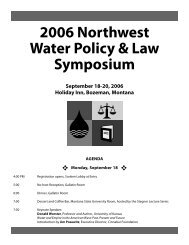aquaculturehealth - Montana Water Center - Montana State University
aquaculturehealth - Montana Water Center - Montana State University
aquaculturehealth - Montana Water Center - Montana State University
You also want an ePaper? Increase the reach of your titles
YUMPU automatically turns print PDFs into web optimized ePapers that Google loves.
NEW DISEASE IDENTIFIED<br />
IN NORWAY’S FARMED COD<br />
BY DR ANNE-BERIT OLSEN, JARLE MIKALSEN AND DR DUNCAN COLQUHOUN, (NATIONAL VETERINARY INSTITUTE, NORWAY)<br />
FINFISH<br />
FIGURE 1: SPLEEN LESIONS IN AN INFECTED FISH<br />
Apreviously undescribed granulomatous disease in Atlantic<br />
cod (Gadus morhua L) related to the presence of a Gramnegative,<br />
facultative intracellular bacterium belonging to<br />
the genus Francisella has recently been identified in Norway.<br />
The initial outbreak was identified in a population of mature<br />
cod weighing 2-4kg held in an enclosed natural seawater “basin”<br />
on the western coast of Norway. Increased levels of mortality<br />
were registered in July 2005 at a water temperature of around<br />
14.5˚C and peaked in August. Accumulated mortality<br />
reached approximately 40 percent in the five months<br />
from July to November. Other pathogenic<br />
agents were not thought to have<br />
contributed significantly to this total.<br />
CLINICAL AND<br />
PATHOLOGICAL<br />
FINDINGS<br />
Externally, the fish appeared to have a<br />
generally emaciated condition. Some<br />
individuals displayed raised haemorrhagic<br />
nodules in the skin. All moribund fish<br />
caught for examination showed extensive<br />
internal gross lesions, with moderate to massive<br />
occurrence of white, partly protruding nodules of<br />
various sizes in the spleen (see Figures 1 and 2), the heart<br />
(Figure 3), kidney and liver.<br />
The spleen was enlarged and sero-haemorrhagic ascites and<br />
thickened intestinal mucosa were observed. Extensive chronic<br />
granulomatous inflammation with multiple granuloma in all<br />
organs was the main histopathological finding. Few to<br />
numerous small Gram-negative bacteria were found<br />
intracellularly in the granulomas.<br />
IDENTIFICATION OF ISOLATED BACTERIA<br />
The bacterium associated with the infection does not grow on<br />
standard microbiological media, but grows well in cell culture and<br />
on media with a high cysteine content. A nearly complete<br />
16S ribosomal RNA sequence was obtained showing a high degree<br />
FIGURE 3: HEART LESIONS ARE ANOTHER SYMPTOM OF THE CONDITION<br />
FIGURE 2: SEVERE LESIONS IN<br />
AN EXCISED SPLEEN<br />
of homology with<br />
Francisella spp, including<br />
isolates previously identified in fish in<br />
Taiwan (tilapia) and Japan (three-lined grunt).<br />
Although the present isolate has yet to be fully described, the<br />
phenotypical evidence so far available comprises compelling<br />
evidence for its inclusion within the genus Francisella.Ofthe<br />
limited temperatures tested, the best growth was identified at 22˚C,<br />
with very weak growth registered at 30˚C and no growth at 37˚C,<br />
suggesting that the bacterium is probably incapable of surviving<br />
within a mammalian host.<br />
OCCURRENCE<br />
So far three outbreaks have been confirmed by bacterial isolation.<br />
Histopathological findings consistent with those described above<br />
have been identified in several other cases currently under<br />
microbiological investigation.<br />
■<br />
FEBRUARY 2006 AQUACULTURE HEALTH INTERNATIONAL 7






